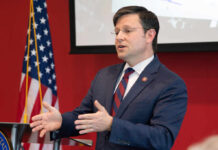
While experts in crisp white lab coats assure us of infallible safety measures, a new biosecurity laboratory opens its doors in Manhattan, Kansas. We are told that this lab, intended to study deadly animal diseases, poses no threat to the surrounding agriculture-heavy community. However, critics demand to know whether the potential risks outweigh the projected benefits.
The National Bio and Agro-Defense Facility (NBAF), a $1.25 billion project, took nearly a decade longer to complete than initially planned. Operated by the U.S. Department of Agriculture, the NBAF is poised to become a premier laboratory for handling deadly animal pathogens, like the Nipah virus, in a secure environment. Its proponents argue the NBAF will “change the research landscape,” but the question lingers — at what cost?
Government Science™ Opens New Biolab Studying Animal Pathogens in Middle of Kansas https://t.co/AO7HFCytMX
— PJ Media (@PJMedia_com) May 30, 2023
Even the NBAF’s supporters cannot deny that an accidental leak of hazardous pathogens could wreak havoc in America’s agricultural heartland. For example, despite its limited influence, the Kansas Cattlemen’s Association has expressed valid concerns. According to Larry Kendig, a board member of the Kansas Cattlemen’s Association, if a highly contagious animal disease escaped, it would “shut down commerce.”
The NBAF is expected to supersede the Plum Island Animal Disease Center in New York, becoming a new Alcatraz for deadly diseases. The facility boasts more than 53,000 square meters of floor space, the ability to handle large animals, and strict safety protocols, including specialized equipment like “moon suits.” The lab’s overseer, the U.S. Department of Homeland Security, selected Manhattan for its “broad community acceptance” and emergence as an animal disease research hub.
However, the controversy surrounding the lab’s location in a productive cattle and crop area is concerning. Cases of bio-lab mishaps aren’t unheard of. The 2007 foot and mouth disease outbreak in the U.K., linked to a leak at an animal health lab, and concerns about the lab’s location in a tornado-prone area fuel the debate.
Laura Kahn, a biodefense expert, calls the decision to establish NBAF in the heart of livestock country “real hubris.” Furthermore, a 2010 DHS evaluation suggested that over 50 years, the Kansas lab could have a 70% chance of triggering a foot and mouth disease outbreak. However, a follow-up study, heavily criticized by a U.S. National Academies of Sciences panel, reduced this risk to a dubious 0.11%.
However, Gerald Epstein, former deputy assistant secretary of homeland security, assures that the facility is safe and necessary in the face of emerging infectious diseases. Lisa Hensley, an epidemiologist, and virologist at the NBAF, adds a personal testament to her confidence, having moved her family to Manhattan to help run the lab.
It is an age-old struggle — the advancement of science weighed against potential risks. We do not undermine the importance of studying these deadly diseases or doubt the intentions of those involved. But, we question the wisdom of placing such a facility in the agricultural backbone of our nation. After all, prevention is often better than cure. When it comes to biosecurity, we cannot afford to learn the hard way.





























